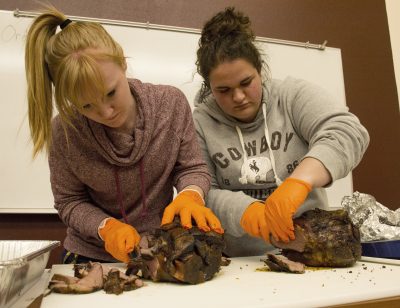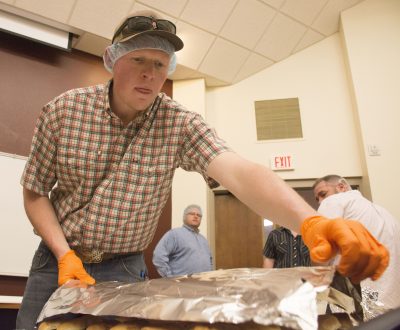The caramelized and long-cooked leg of lamb, skewered marinated kabobs, chops and slow-cooked shoulder meat brought into the classroom was the tip of the iceberg in the animal science 4230 class at the University of Wyoming.

Officially “Advanced Sheep Production Management,” the course description states the spring semester class integrates animal breeding, nutrition, and reproductive physiology in sheep production management schemes.
Unofficially, assistant professor Whit Stewart navigates students from the hoof to slaughter and eventually to the portions of lamb the more than 30+ students and a few others would critique as part of the class final.
From hoof to plate
Stewart shepherds Department of Animal Science students through the lambing shed, lamb feeding, how to body condition score sheep, diseases, how to evaluate wool, and seeing the carcasses on the rail. The meat served this day was from carcasses judged at the recent state 4-H and FFA meats contest in Laramie and an earlier carcass evaluation portion of the class.
Stewart said having students involved from hoof to plate preparation is a unique aspect of the class.
“They get everything related to the industry,” he said. “(Today) was the lamb preparation lab final. When you look across the country, sheep production classes usually don’t focus on that, but it’s a good way to end the semester and engage them in a different way than we have the previous few weeks.”
Enrollment continues to grow in the class and other sheep-specific curriculum
Recent data, Stewart said, shows more millennials are interested in eating lamb due to its unique flavor profile and versatility in traditional and ethnic culinary applications. In general, lamb has a unique, robust flavor compared to beef and can be influenced by breed, country of origin and the sheep diet.
About 5 million head of sheep were raised in 2016 in the U.S., according to the USDA. There were about 360,000 in Wyoming; the state ranks fourth in total sheep and lamb production and third in breeding sheep numbers. Wyoming’s sheep industry has grown 4 percent since 2015, according to the recently released Census of Agriculture.
Stewart has described Wyoming as the wine country of the nation’s sheep country for wool. The state produced the highest-valued wool clip in 2017 ($4.4 million or $2 a pound), according to USDA-National Agricultural Statistics Service Information Sheep and Goat Report estimates released in 2018. Utah was second at $4.1 million in total value.
“People come from all over the world to buy our wool,” he said.
Sees producer appreciation
Stewart said many of the state’s sheep producers express on Facebook pages an appreciation of how many students are in the sheep production class.

“I’m taken aback they are taken aback there is interest in the industry,” said Stewart, the UW Extension sheep specialist. “We are working with an extremely productive livestock species that provides meat and wool on very low-input resources. Why shouldn’t there be interest? But I think it reflects the millennial demographic. They are more willing to try lamb, and we are also seeing in our ag students an open mind to add sheep to an existing enterprise.”
Students were broken into groups of five, and Stewart assigned each group a choice of three recipes from the American Lamb Board to prepare under the scrutiny of other class members. Stewart wanted to target different non-traditional, lower-price point muscle cuts and their preparation. Food was judged on external and internal visual appearance, aroma, presentation of the product, taste, tenderness and other aspects.
Stewart wanted to highlight recipes that go beyond the lamb burger and lamb chop.
“A lot of cuts we can prepare similar to how we prepare beef – braised, slow cooked, marinated kabobs,” he said. “We wanted to highlight the diversity so they would, one, know of the great recipe resources at the American Lamb Board, and two, advocate for more lamb products.”
The recipes
The students prepared braised shoulders, lamb chops, ground lamb and leg of lamb recipes:
* Smoked American leg of lamb with Texas-style dry rub – bit.ly/legoflambrub
* Slow roasted lamb shoulder with pomegranate apricot glaze – bit.ly/shoulderglaze
* Southwestern lamb shoulder roast – bit.ly/southwestroast
* Tzatziki stuffed American lamb burgers – bit.ly/stuffedlambburgers
* Greek lamb burgers with tzatziki grilled red onions – bit.ly/tzatzikilambburgers
These and many others are at bit.ly/deliciouslamb.





